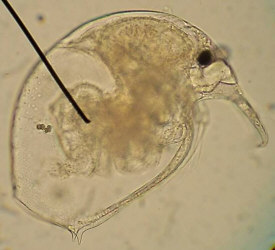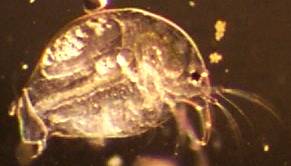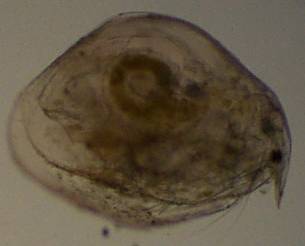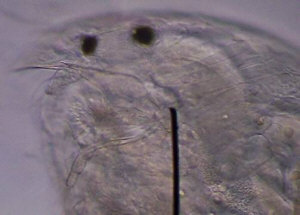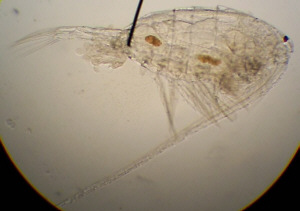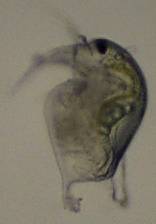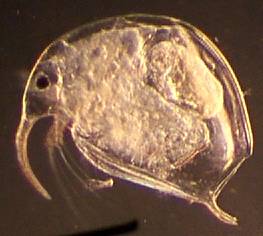Part
one of this series.
Part
two of this series.
Part
four of this series.
Issue:
 Plankton
nets are not cheap to buy, and though there are numerous plans for making
them, the sewing and construction can get complex (for a relatively easy,
and good design see Howard
Taylor's rotifer net). I decided to see what sort of net I could
create cheaply and easily, and what results it would produce.
Plankton
nets are not cheap to buy, and though there are numerous plans for making
them, the sewing and construction can get complex (for a relatively easy,
and good design see Howard
Taylor's rotifer net). I decided to see what sort of net I could
create cheaply and easily, and what results it would produce.
The Equipment Basics:
I had seen a butterfly net that
looked like someone had taken some fabric and held it in place with a needle-point
hoop. While a wooden needle-point hoop might not hold up very well in water,
it was the start of an idea. I sliced a 1 inch ring off a 6" PVC pipe,
and drilled several holes around the edge for attaching a tow line. Combined
with a 6" hose clamp, I now had a hoop to hold the net. For the net, I
borrowed (permanently - she no longer wants it back) one of my wife's knee-high
nylon stockings. It may look a little funny, but it definitely does a nice
job. The weave is fine enough to collect small daphnia and algae. I have
not experimented to see if different styles of stockings produce different
results.
Use:
I tried several attempts at throwing
the net out from the shore of a pond and pulling it back in, but so far
this has had poor results (possibly due to location as much as technique).
My first good results were when I
bribed my sons into going with me on a daphnia collecting trip to Forest
Park, by promising them a paddle-boat ride. They merrily paddled along
while I towed the net about 12 feet behind the boat. It is a relatively
shallow pond (more a reflecting pool left over from the 1904 Worlds Fair),
but the results were astounding. The net had a 1/4 inch layer of algae
coating it, and a rich population of daphnia. All the more interesting
as they were new genera (to my collecting), being small pelagic species
(Chydoridae and Bosminidae).
While on vacation in Michigan, we
spent several days at the Lake Michigan beaches around St. Joseph. While
the kids played in the sand, I was looking out to deeper water, wondering
what it would take to get a boat and go out towing. Accepting the fact
that I had to stay family oriented, I started wondering if there was anything
along the shore worth collecting. Rather than towing the net, I tried holding
it like a hoop seine (holding the fabric up so only a portion of it covered
the opening) and waving it back and forth through the water. Every little
bit I would rinse the fabric in a small container; in this way, I was able
to concentrate the plankton into denser quantities. Lake Michigan is cold
(I probably need to add a thermometer to my collecting equipment), so I
didn't venture out beyond knee depth. From prior bottle collecting in the
waves, I knew there were some interesting daphnia. Most of the animals
were copepods, but again I found some new genera.
Observations:
June 17, 2001 - Forest Park, St.
Louis, MO (UTM 15 736122E 4280027N)
For little work, the net
adds a lot of value to my collecting. It is small enough to fit in a back-pack,
so is easy to carry around on the off chance it may be useful. It will
definitely become another one of my standard tools, to be pulled out at
opportune times.
Technical Note on Photographs:
All pictures were taken with my Kodak
3200 digital camera. The 'good' images are about 576x432, while the 'best'
images are 1,152x864 (1 megapixel). The photomicrographs have been cropped,
but not enhanced or resized (except where stated).
The Maritime Museum is accessible
at: www.michiganmaritimemuseum.org
Comments to the author Howard
Webb are welcomed.
Microscopy
UK Front Page
Micscape
Magazine
Article
Library
 Plankton
nets are not cheap to buy, and though there are numerous plans for making
them, the sewing and construction can get complex (for a relatively easy,
and good design see Howard
Taylor's rotifer net). I decided to see what sort of net I could
create cheaply and easily, and what results it would produce.
Plankton
nets are not cheap to buy, and though there are numerous plans for making
them, the sewing and construction can get complex (for a relatively easy,
and good design see Howard
Taylor's rotifer net). I decided to see what sort of net I could
create cheaply and easily, and what results it would produce.